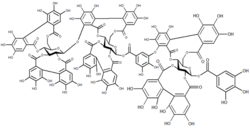Macromolecule facts for kids
A macromolecule is a super big molecule. Think of it like a giant LEGO creation made from many smaller LEGO bricks. These big molecules are usually called polymers. Polymers are built from smaller, repeating units called monomers. Most macromolecules in living things are based on the element carbon. They also often contain hydrogen, oxygen, and nitrogen. Some macromolecules are not based on carbon, but they are less common.

Contents
What are Macromolecules?
Macromolecules are simply very large molecules. The word "macro" means large, so it's a "large molecule." These giant molecules are often made by linking many smaller molecules together. Imagine connecting many paper clips to form a long chain. Each paper clip is a small molecule, and the whole chain is a macromolecule.
How Macromolecules are Built
Most macromolecules are polymers. This means they are long chains made from many repeating units. These smaller, repeating units are called monomers. It's like building a wall with many identical bricks. Each brick is a monomer, and the whole wall is a polymer (a macromolecule).
Most macromolecules found in living things, like plants and animals, are made of carbon. They also usually contain hydrogen, oxygen, and nitrogen. However, some macromolecules are not based on carbon.
Important Types of Macromolecules
Macromolecules are super important for life and for many materials we use every day. Here are some key examples:
- Proteins: These are like the tiny machines and builders in your body. They are made from smaller units called amino acids. Proteins help your body grow, repair itself, and fight off sickness. They also help carry oxygen and make muscles work.
- Nucleic Acids: These molecules carry genetic information. The most famous one is DNA, which is like a blueprint for your body. DNA is made of smaller units called nucleotides.
- Carbohydrates: These are energy sources for your body. Sugars and starches are types of carbohydrates. They are built from simple monosaccharide sugars.
- Lipids (Fats): These molecules store energy and are important parts of cell membranes. They are made from fatty acids and triglycerides.
- Nylon: This is a human-made macromolecule, a type of plastic. It's used to make clothes, ropes, and many other things. It's made of repeating units called polyamides.
- Polythiazyl: This is an interesting inorganic macromolecule. It's made of repeating units of sulphur nitride.
Images for kids
-
Chemical structure of a polypeptide macromolecule. This shows how many smaller parts link up to form a large protein.
See also
 In Spanish: Macromolécula para niños
In Spanish: Macromolécula para niños


